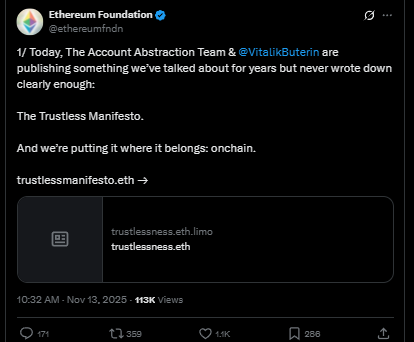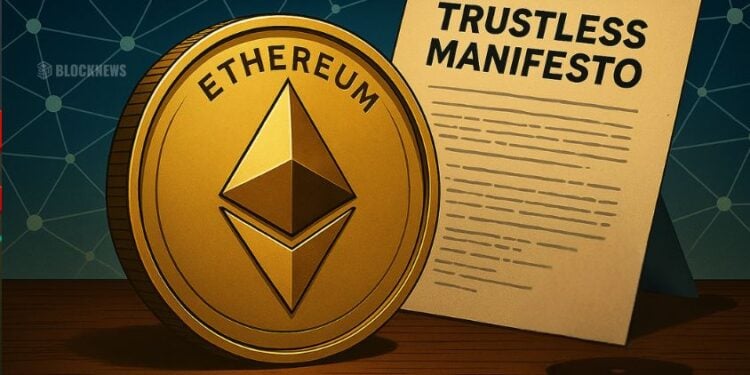- Vitalik Buterin and the Ethereum Foundation introduced the Trustless Manifesto to re-emphasize decentralization, neutrality, and censorship resistance.
- The manifesto warns developers against shortcuts like hosted nodes or centralized relayers, which gradually weaken Ethereum’s trustless design.
- EF also shut down the Holešky testnet after upgrades like PeerDAS and Pectra made it unnecessary moving forward.
The Ethereum Foundation, alongside Vitalik Buterin, just rolled out something that feels like a return-to-roots moment for the entire ecosystem: the Trustless Manifesto. It’s basically a reminder — or maybe a warning — that Ethereum’s core values shouldn’t get lost in the rush for convenience. The message is loud but not exactly new: decentralization, censorship resistance, neutrality, and self-custody aren’t optional add-ons… they are Ethereum. And the foundation seems determined to put those principles back front and center.

The Vision Behind the Trustless Manifesto
The manifesto was co-authored by Vitalik Buterin and EF researchers Yoav Weiss and Marissa Posner. They admitted that this wasn’t some sudden idea — the conversation had been floating around for years without anyone actually putting it into motion. Now, though, the team says they’re finally “putting it where it belongs: onchain,” which feels symbolic in all the right ways.
At its core, the Trustless Manifesto pushes developers to avoid shortcuts that slowly centralize the network. Hosted nodes, centralized relayers, convenience-driven checkpoints — all the little things that seem harmless at first — eventually chip away at Ethereum’s permissionless nature. According to the EF, every single “quick fix” adds friction to decentralization, and over time those tiny compromises can turn into choke points. The manifesto explicitly defends values like credible neutrality, verifiability, and firm resistance to what it calls “convenient centralization.”
One line from the authors hits especially hard: “Trustlessness is not a feature to add after the fact. It is the thing itself.” And honestly, that’s the kind of reminder Ethereum’s ecosystem probably needed right now.
Why This Matters for Developers
The manifesto is basically telling builders: don’t sacrifice Ethereum’s foundation for faster growth or easier onboarding. If something requires a trusted intermediary, a dependency on a centralized service, or a checkpoint that decides what is “valid,” then it’s probably steering the network off-course.
Vitalik and the EF warn that rising complexity — especially in rollup infrastructure — often tempts developers toward centralization. It’s faster, it’s cleaner, it avoids headaches. But it also creates single points of failure that go against everything Ethereum stands for. The document encourages devs to stay intentional, keep things verifiable, and preserve the protocol’s neutrality, even if that means slower adoption at first.
EF Shuts Down Holešky Testnet After Recent Upgrades
This manifesto drop comes as the Ethereum Foundation continues adjusting its technical roadmap. Just weeks earlier, the EF officially shut down the Holešky testnet — a massive testing environment launched in 2023. Holešky played an important role in validating features for the Pectra upgrade (completed in May 2025), but it eventually ran into issues: validator inactivity leaks, long exit queues, and operational friction that made it tough to maintain.
Since the Fusaka upgrade testing wrapped up (introducing PeerDAS, which cuts validator bandwidth requirements and boosts L2 scalability), Holešky’s role was basically fulfilled. The EF decided it was time to sunset it and move on with more efficient testing infrastructure.














